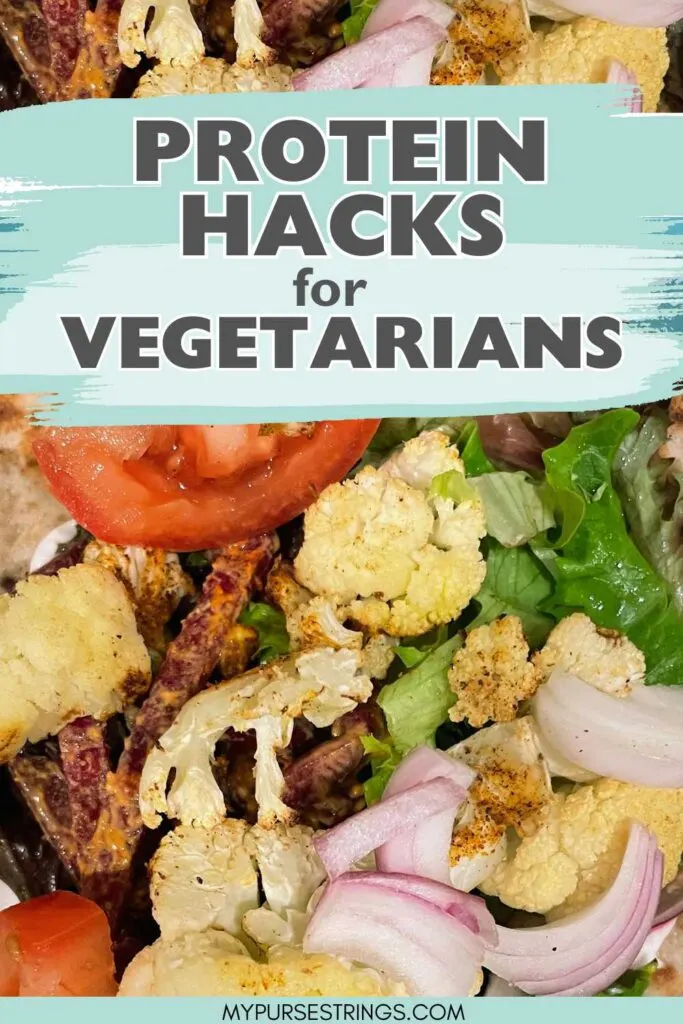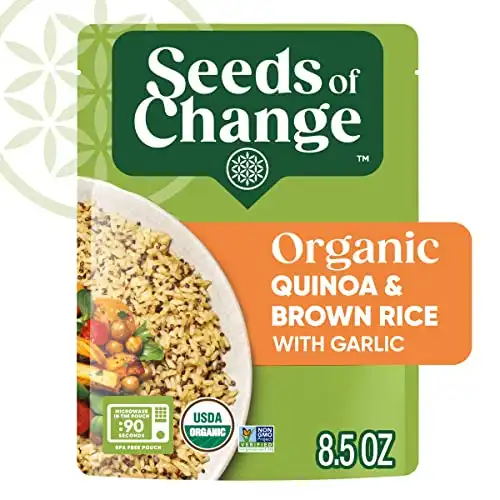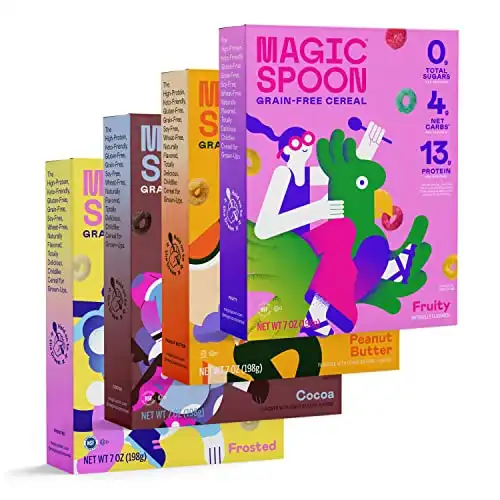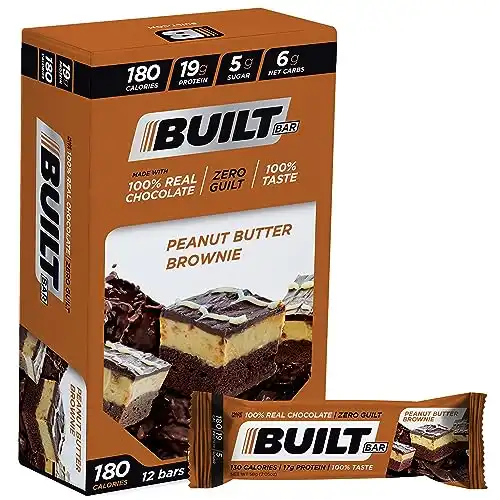When people learn I am a vegetarian, inevitably the first concern they have for me is whether I’m getting enough protein. I get plenty of protein. And how do I know? Because I track my macros.
It’s taken me a while to figure out what works but I’m here to share some of my favorite protein hacks for vegetarians.
This post contains affiliate links. See my disclosure policy for more information.
Key Takeaways from My Journey:
- You don’t need animal protein to get protein
- I get as much protein from plants as I did from eating meat
- Finding vegetarian protein sources makes meals interesting and colorful
My Top 25 Protein Hacks:
Over time, I’ve curated a list of my favorite protein hacks that keep my meals exciting and help me to reach my nutrition goals:
1. High Protein Grains
Instead of rice or pasta, replace your grains with quinoa, farro, spelt, kaumut, or couscous.
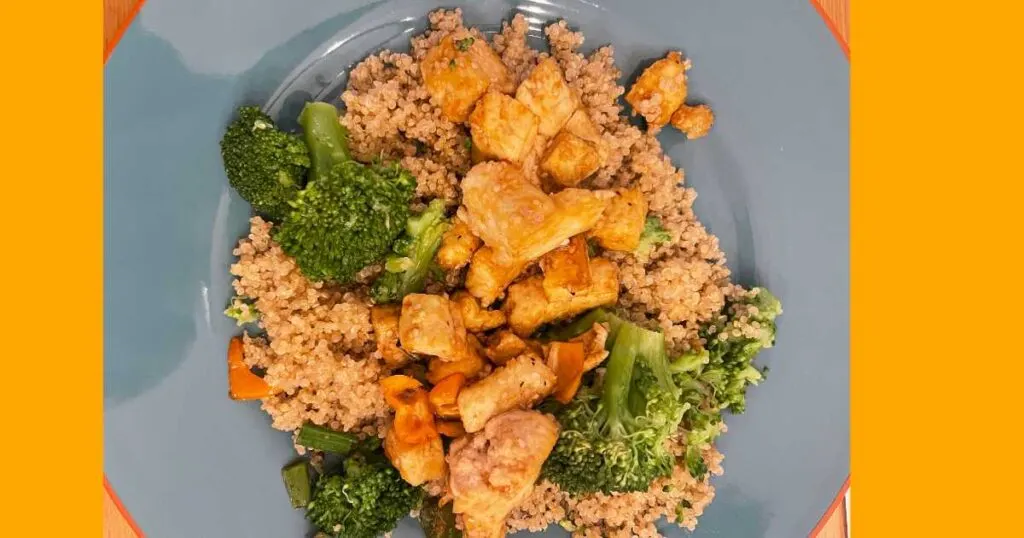
Quinoa
- Protein: Quinoa has 8 grams of protein and is a complete protein, meaning it has all nine essential amino acids, which is rare for plant-based foods. This makes it an excellent protein source, especially for vegetarians and vegans.
- Fiber: It has 5 grams of dietary fiber. High fiber is beneficial for digestive health.
- Gluten-Free: Quinoa is naturally gluten-free, making it a great option for people with celiac disease or gluten sensitivity.
Farro
- Protein: Unlike quinoa, farro is not a complete protein, However, it is still a good source of protein, especially for a grain, and has about 6 to 8 grams of protein per 1-cup serving when cooked.
- Fiber: Farro is high in dietary fiber, with about 5 to 8 grams per 1-cup serving (cooked).
- Not gluten-free
Spelt
- Protein: Spelt contains about 5 to 6 grams of protein per 1-cup serving when cooked. It’s not a complete protein.
- Fiber: It has 5 to 7 grams per 1-cup serving cooked.
- Not gluten-free
Kamut
- Protein: about 9 to 10 grams per 1-cup serving when cooked. This makes it one of the higher-protein grains, and this is a great side dish to boost protein intake.
- Fiber: about 7 to 10 grams per 1-cup serving (cooked).
- Not gluten-free
Couscous
- Protein: made from semolina flour and has about 6 grams of protein per 1-cup serving when cooked.
- Fiber: Couscous has a moderate amount of dietary fiber, with about 2 to 3 grams per 1-cup serving when cooked.
- Not gluten-free
Other options
- Wild rice has a good protein content, about 6 to 7 grams of protein per 1-cup serving when cooked.
- Brown rice provides a moderate amount of protein, about 4 to 5 grams per 1-cup serving when cooked.
- White rice only has about 2 to 3 grams of protein.
Quick Tip: if you need an easy, quick meal, I love Seeds of Change Brown Rice & Quinoa. Just pop the bag into the microwave for 90 seconds and you have an extra 5 grams of protein (per serving) to add to any meal.
As you can see, quinoa comes out on top for me as it’s the only one that is a complete protein.
2. Substitute with Pea Protein Milk
This is one of my favorite ways to add protein, especially at breakfast time. A glass of pea protein milk has 8 grams of protein. Add that to any cereal, oatmeal, or smoothie.
In contrast, my usual almond milk has only 1 gram of protein and my go-to oat milk has 2 grams of protein.
3. Sprinkle Chia Seeds and Hemp Seeds
I sprinkle chia seeds and hemp seeds on everything from my oatmeal, smoothies, yogurt, pasta, sandwiches, and veggies. This is an easy way to up your protein and you hardly notice them.
Chia seeds
A 2-tablespoon serving of chia seeds contains around 4 to 5 grams of protein.
Hemp seeds
For a 2-tablespoon serving of hemp seeds, you would get approximately 6 to 7 grams of protein.
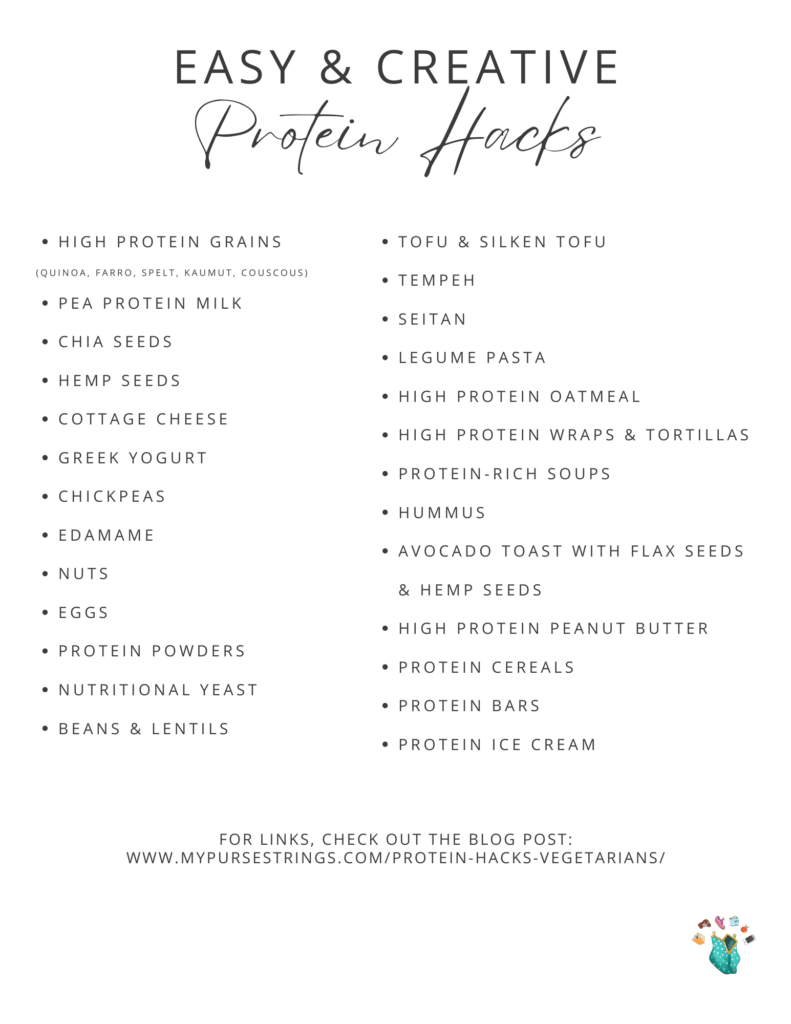
4. Sneak in Cottage Cheese
While sometimes I try to avoid dairy products, when I don’t, triple-down on cottage cheese. I find a way to sneak it into various foods including scrambled eggs, and pasta, and spread it on Scandanavian GG crackers, which are high in fiber.
A half-cup of low-fat cottage cheese contains about 14 grams of protein, and it’s low-carb too. Combine that with two eggs and you have around 26 grams of protein!
5. Use Greek Yogurt
If you don’t like cottage cheese, try Greek Yogurt.
Use creamy Greek yogurt as a base for dips and dressings or mix it with fruit and granola for a protein-packed breakfast or snack.
One cup of non-fat Greek yogurt contains around 18 grams of protein, making it a good choice for vegetarians looking to increase their protein intake.
6. Snack on Roasted Chickpeas
One of my tried-and-true appetizers to serve when hosting guests is roasted chickpeas. I used to bake it in the oven for about an hour with some spices (usually chili powder but sometimes za’atar) but once I switched to an air fryer, I could make it in about 20 minutes. I eat it more often now given its convenience.
Chickpeas have 15 g of protein per cup.
7. Put Edamame on Everything
I’m lazy and keep a bag of Trader Joe’s cooked edamame in the refrigerator at all times. I also have the frozen (unshelled of course) version. I add edamame to salads and pasta, and eat it on its own as a snack or my favorite dinner, I call “a little bit of this and a little bit of that.”
Edamame is a plant-based protein source that’s also high in fiber and low in calories. One cup of edamame contains 17 grams of protein, making it a great option for vegetarians looking to increase their protein intake.
8. Eat Nuts by the Handful
Yes, you have to be careful with the caloric content of nuts, but if you measure them out, they’re a great source of protein.
One way to save on calories is to crush them. Then I mix them into salads and in stir-fries. They’re perfect for adding crunch and protein to meals. Just a 1/4 cup of almonds has 6 to 7 grams of protein.
9. Eggs in Surprising Ways
I’m not vegan obviously, and one of the things I love doing is adding eggs to sandwiches (especially with hummus), to my veggie platters, and again, into my stir-fried meals.
If you’re craving an egg sandwich, place a fried egg in between two slices of Carbonaut bread, which is low in net carbs but high in fiber. Craving a bagel? Try out The Better Bagel, a low-carb, high protein bagel.
I also eat poached eggs made in the Instant Pot pretty regularly served alongside some sliced avocado.
10. Protein Powders Are Your Friend
Sure, you can make a protein shake, but I have some more innovative ways to use it.
Peanut Butter Protein Powder
If you like the taste of peanut butter, add some flavored protein powder to smoothies, oatmeal, and even noodles. It’s 21 grams per 2 scoops, but I generally just add one.
Quick Tip: if you need a quick meal, Costco sells Yakisoba noodles with vegetables. I often sprinkle a bit of Orgain peanut butter protein powder into it.
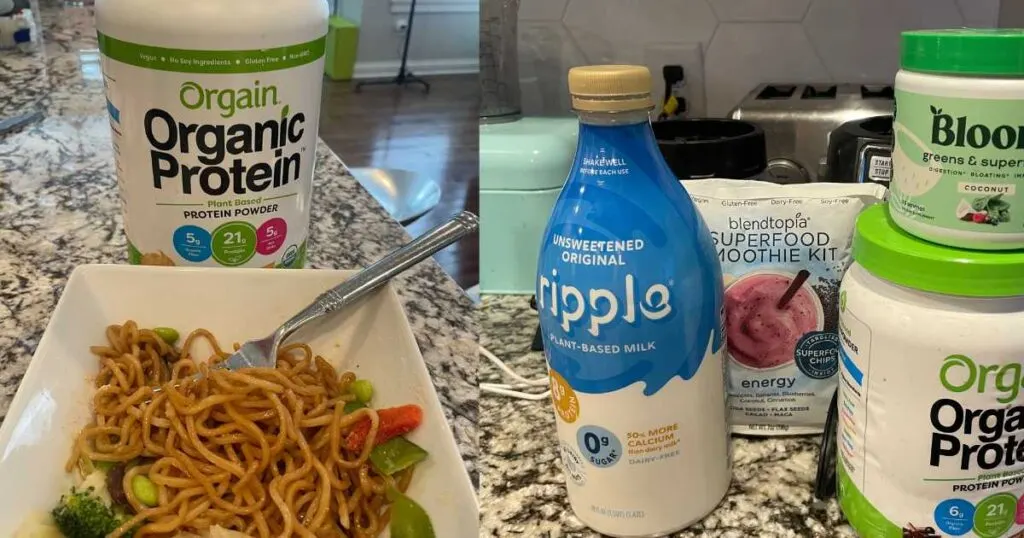
Bake with Protein Powder
Rather than buying premade mixes and paying more for them, add your favorite plant-based protein powder to everything from muffins to pancakes, and waffles.
There are many different types of protein powder available, including whey, soy, and pea protein, so be sure to choose one that fits your dietary needs and preferences.
Protein Powder Hot Chocolate
I drink Orgain Peppermint Hot Cocoa at least once per week. I mix it with Ripple milk (best with chocolate flavor), use my frother, and sometimes top it with some whipped cream. This after-dinner snack usually has about 19 grams of protein in it.
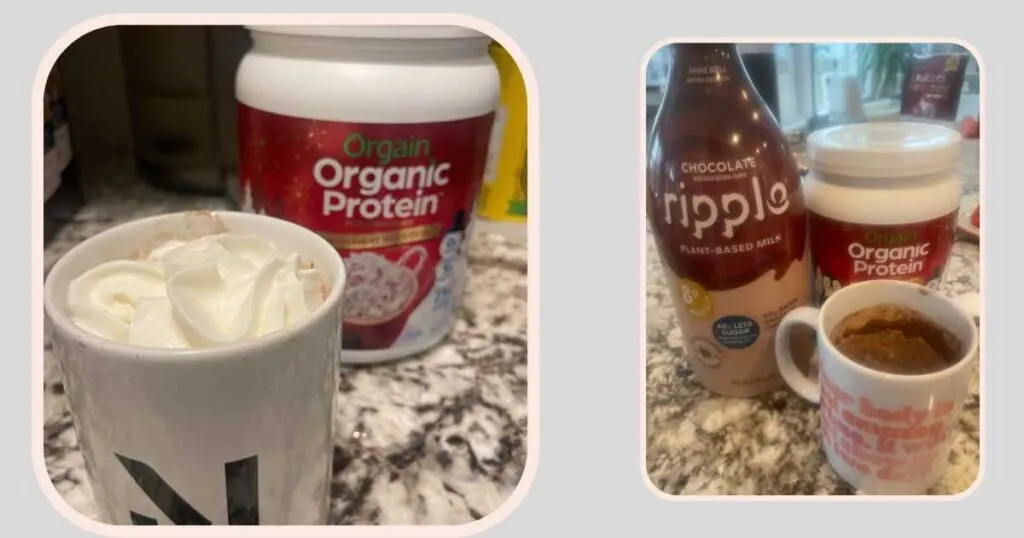
11. Cook with Nutritional Yeast
Nutritional yeast adds a cheesy flavor and protein to dishes like popcorn and pasta. It’s also great mixed into mashed potatoes or scrambled eggs.
Just two tablespoons of nutritional yeast contains 9 grams of protein, making it an easy and delicious way to boost your protein intake.
12. Mix Beans and Lentils into Salads
Regularly consuming beans and lentils is a simple way to boost protein in any salad:
- Black beans: 7 to 8 grams of protein for 1/2 cup serving
- Pinto beans: 6 to 8 grams of protein for 1/2 cup serving
- Lentils: 9 grams of protein for 1/2 cup serving
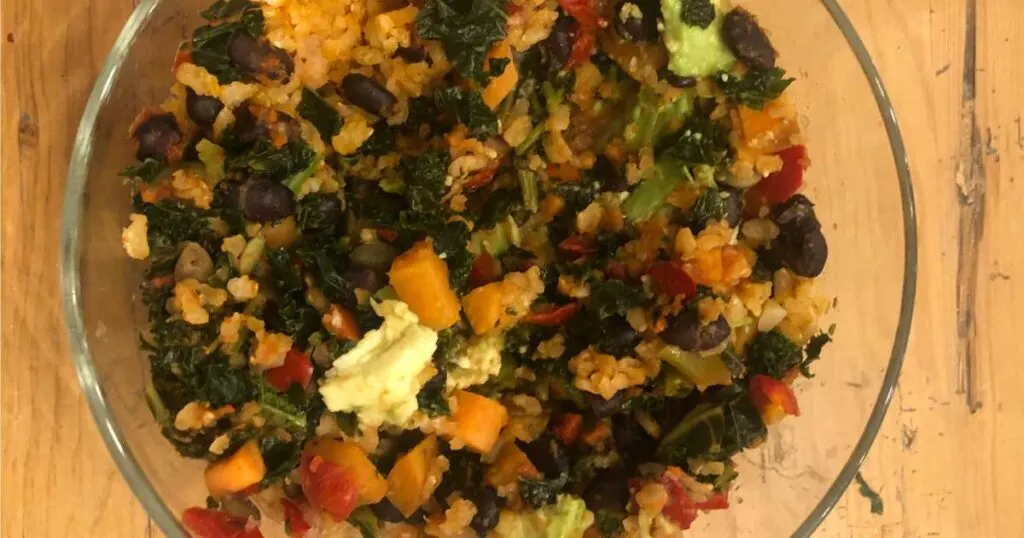
13. Incorporate Tofu and Tempeh
Versatile and protein-rich, tofu and tempeh are excellent meat substitutes.
Tofu typically has 14 grams per serving, and tempeh can have 18 grams per serving.
Quick Tip: spray a little avocado oil over tofu and pop it into the air fryer. You need no heavy oils and it gets crunchy on the outside and soft on the inside.
14. Blend in Silken Tofu
Silken tofu gives desserts and smoothies a touch of creaminess and a ton of protein without altering the flavor and has between 4 to 6 grams of protein per serving.
15. Seitan
Seitan, also known as wheat meat, is a high-protein, vegetarian meat substitute made from wheat gluten. It has a meaty texture and can be used in place of meat in many recipes. I like to use seitan in stir-fries, tacos, and sandwiches for a protein-packed meal. One serving of seitan contains around 18 to 20 grams of protein, making it one of the highest protein sources available to vegetarians.
Note: As you can see, I don’t eat too many mock meats like veggie burgers as I try to stay away from processed foods. Although when I’m in a rush, I sometimes add veggie chicken nuggets to a salad or bowl.
16. Opt for Legume Pasta
I never eat regular pasta unless I’m at a restaurant. Legume pasta tastes so good and usually comes in the form of chickpeas or lentils.
Quick Tip: I always have bags of Daily Harvest legume pasta in the freezer. Within minutes, I can have a filling meal with interesting sauces. Read my comparison of Daily Harvest and Splendid Spoon here.
Save $65 off your first order with promo code PURSESTRINGS
If you like ramen, Chef Woo makes a vegetarian version and it has 20 grams of protein!
17. High Protein Oatmeal
I regularly buy oatmeal that already has added protein in it like the Health Warrior brand. But I also just add some of my own protein powder to a bowl. I also almost always choose to use Ripple milk as my liquid, instead of almond milk or plain water.
If you’re looking for an interesting oatmeal, I recommend Ryze mushroom overnight oats, with 20 grams of whey protein. It doesn’t taste like mushrooms but has added benefits like increased focus, energy, and help with digestion. (Save 15% with code MYPURSESTRINGS15!)
18. Buy High-Protein Wraps and Tortillas
Taco Tuesday is every week at my house. While the rest of my family eats crunchy and soft flour tortillas, I make a vegetarian taco wrapped in lettuce or a high-protein tortilla.
I mentioned before I like to combine hummus and eggs, and it’s even better in a protein wrap.
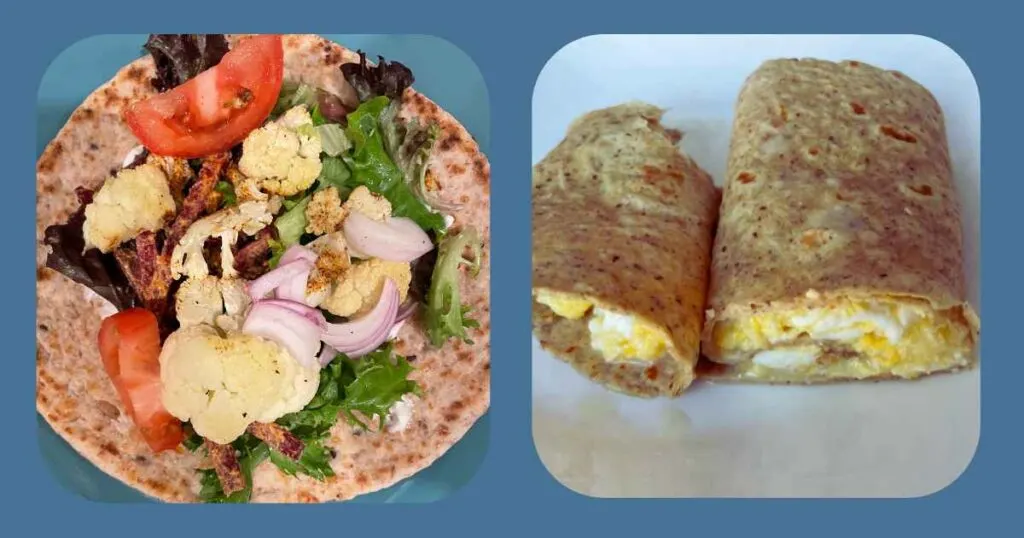
19. Eat Protein Rich Soups
I often make vegetable soups in my Instant Pot. There are tons of recipes out there but I usually incorporate lentils, black beans, or chickpeas. These soups are not only delicious but also very filling.
Both Splendid Spoon and Daily Harvest offer vegan soup options, with interesting flavors and variety.
20. Hummus Every Day
I’m pretty sure I eat hummus every day in some form, usually to dress my salad and most often as a dip for my carrots and other raw vegetables. It doesn’t have as much protein as you would think, only 2 grams per tablespoon, but every bit helps.
21. Avocado Toast with Flaxseeds and Pumpkin Seeds
One of my favorite meals is avocado toast (again usually on Carbonaut bread) with sprouts, a bit of lemon juice, and topped with flaxseeds and pumpkin seeds. You can substitute sunflower seeds if you prefer.
- An avocado has 4 grams of protein.
- A serving (2 tbs) of flaxseed has almost 4 grams of protein.
- A serving (2 tablespoons) of sunflower seeds contains approximately 6 to 7 grams of protein.
For even more protein, mix some white beans in.
Whenever I finish a round of ProLon, this is my Day 6 meal.
22. Add a Scoop of Peanut Butter
While it’s true that I eat hummus daily, I also eat peanut butter at least 5 days per week. I try to buy all-natural peanut butter but I recently discovered Skippy protein peanut butter and I can’t resist it.
It has 10 grams of protein, three more grams than regular peanut butter. One of my favorite breakfasts or snacks is a sliced banana or apple with peanut butter.
23. Protein Cereals
I avoid cereal. It’s processed and usually full of sugar, calories, and zero protein. That was until I discovered cereals higher in protein like Magic Spoon and Three Wishes. Once I top it off with some Ripple Milk, I have at least 16 grams of protein in a bowl.
24. Snack on Protein Bars
I know not all protein bars are created equally. If you’re not vegetarian, I recommend Built Bars, but if you are I really like Fit Crunch and GoMacro bars. You can read all of my protein bar posts here.
25. Protein Ice Cream
I often keep Halo Top ice cream in the freezer but recently, we’re very into using our Ninja Creami ice cream maker.
The secret ingredients are protein powder, pea protein milk, and even some peanut butter. It has a creamy texture and you won’t believe you’re eating healthier ice cream. You can also use it to make smoothie bowls.
Check out MyPurseStrings on Substack. Get the newest blog posts, my favorite finds, and read all new and past newsletters there.
Protein Intake Recommendations
The recommended daily intake of protein varies depending on age, activity level, and weight. According to the Academy of Nutrition and Dietetics, most adults need about 0.8 grams of protein per kilogram of body weight per day. However, athletes and older adults may need more.
Vegetarians can get protein from a variety of sources, including plant-based proteins, dairy, and eggs. While it’s easy to eat the same things every day, it’s important to eat a variety of protein sources to ensure you’re getting all the essential amino acids.
Other Nutritional Considerations for Vegetarians
As a vegetarian, it is important to pay attention to your diet to ensure you are getting all the necessary nutrients your body needs. I record my macros with Cronometer and also use the Lumen Metabolism Tracker throughout the day. Here are some nutritional considerations to keep in mind:
Balancing Macronutrients
Protein is an essential macronutrient that is important for building and repairing tissues, maintaining muscle mass, and aiding in various bodily functions. Vegetarians can get protein from a variety of foods such as legumes, nuts, seeds, and soy products. However, it is important to balance protein intake with other macronutrients such as carbohydrates and healthy fats.
Essential Vitamins and Minerals
Vegetarians need to pay close attention to certain vitamins and minerals that are typically found in animal products:
- Iron: vegetarians can get iron from sources such as beans, lentils, fortified cereals, and leafy greens.
- Calcium: found in sources such as dairy alternatives, leafy greens, and fortified plant-based milks.
- Zinc: found in sources such as legumes and whole grains.
For more information, watch our Protein Hacks video on YouTube, and don’t forget to subscribe.
Overall, these protein hacks are easy to incorporate into your diet and can help you meet your daily protein needs. Whether you’re a vegetarian or just looking to add more plant-based protein to your diet, these options are a great place to start. I hope this list helped you. If you have any recommendations, add them to the comments.

Michelle Platt is a content creator and certified personal trainer. Proving it’s never too late to reinvent yourself, she’s a former attorney and teacher who loves to do the research so you don’t have to. She takes a deep dive into each topic and writes about her wellness journey here. She loves trying out new workouts, fitness tips, healthy foods, and products to share with you. This native New Yorker recently made the move to the suburbs of Minneapolis, where she lives with her husband, two kids, and two dogs.
